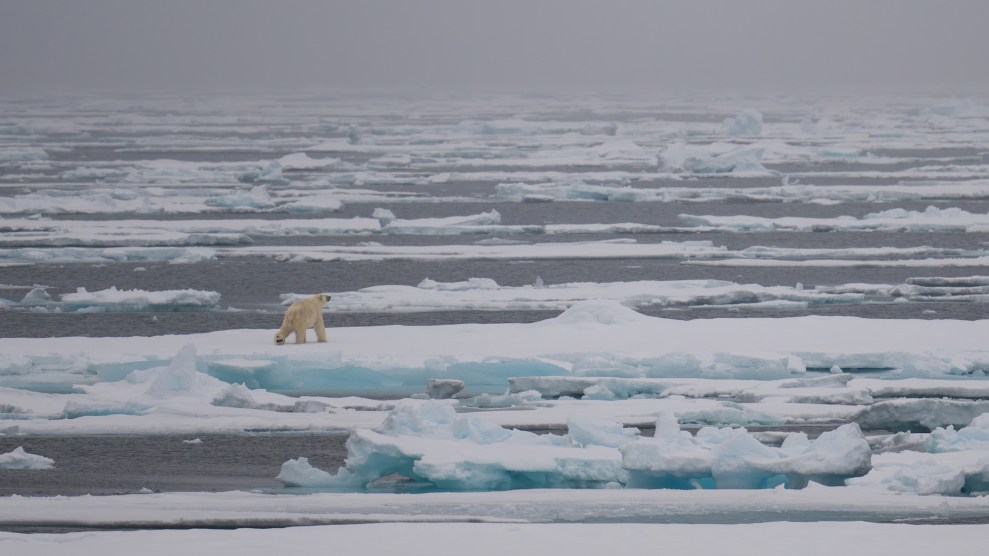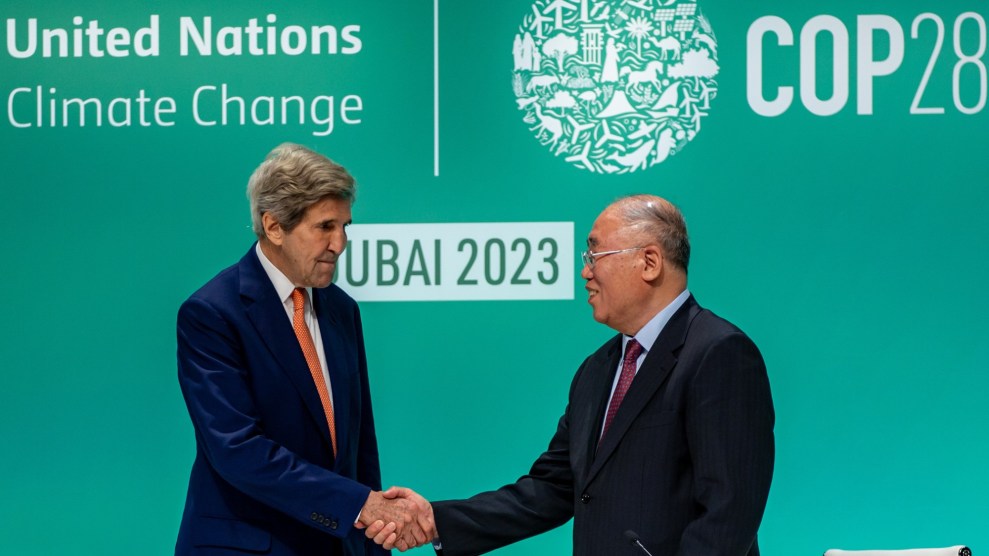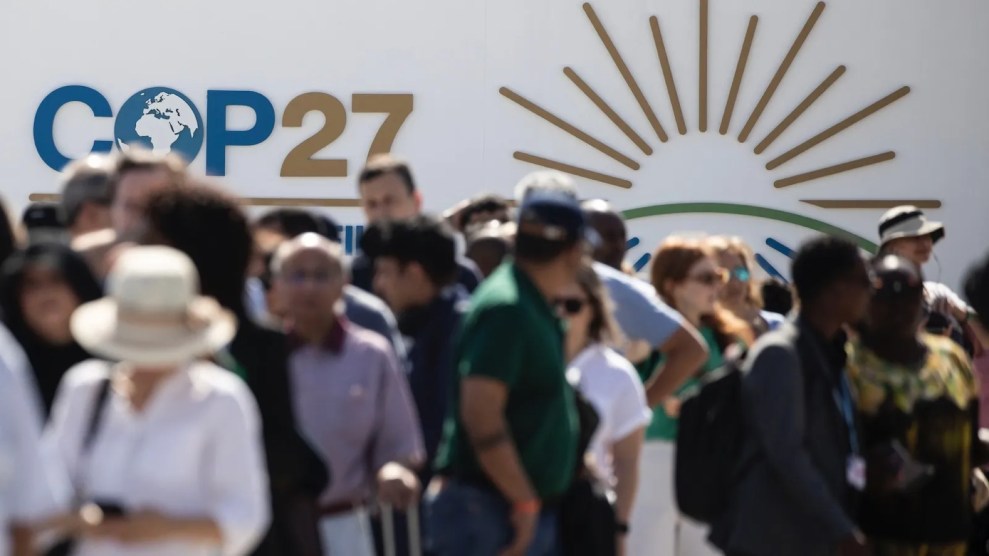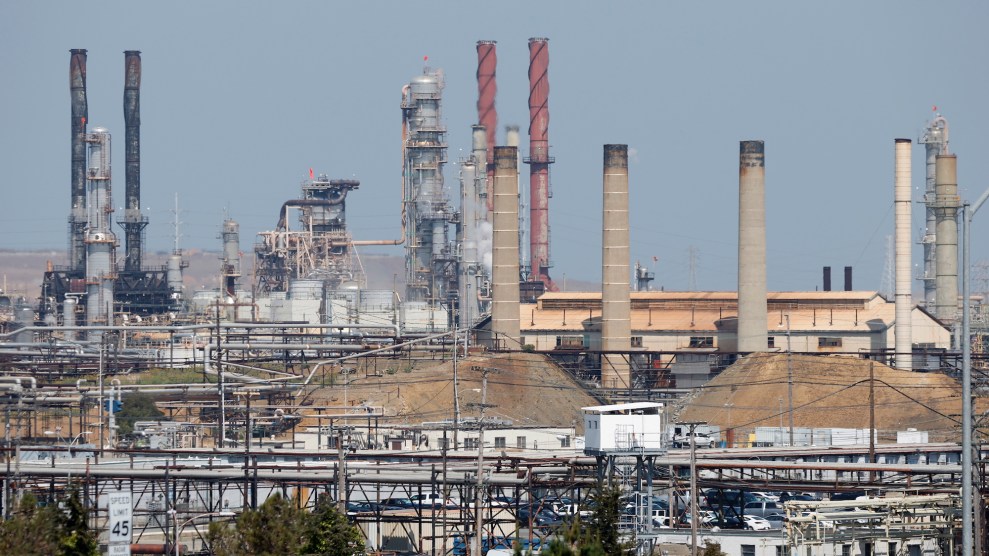
A polar bear walking on melting ice caps in Greenland.Media Drum World/Zuma
This story was originally published by Yale E360 and is reproduced here as part of the Climate Desk collaboration.
Climate negotiators meeting in Dubai last month pledged to chart a course for stabilizing the climate system using good science. But many scientists say these promises are at best ill-defined and at worst a travesty of good science—vague and full of loopholes.
The UN climate conference in Dubai agreed on an action plan for two key objectives: to keep the world on track to limit global warming to 1.5 degrees C (2.7 degrees F), and to stay below this threshold by achieving net-zero greenhouse gas emissions by 2050. Negotiators pledged that both objectives would be pursued “in keeping with the science.”
But neither of the objectives have agreed definitions that would allow a judgment on whether they have been achieved. Two studies published during the Dubai event exposed the problem and revealed wide gaps opening over both the 1.5-degree and net-zero targets, exposing the tensions between political expediency and scientific probity.
On the 1.5-degree target, British meteorologists reported in the journal Nature that a lack of agreement on how to measure global average temperatures is likely to delay formal recognition that the threshold has been exceeded by up to a decade. The result, warns lead author Richard Betts of the UK Met Office’s Hadley Centre, will be “distraction and delay just at the point when climate action is most urgent,” resulting in temperature “overshoot” and a need for highly expensive—and unproven—actions later to reverse warming.
Meanwhile a study headed by Matthew Gidden, a climate modeler at the International Institute for Applied Systems Analysis (IIASA) in Austria, found that the rules governing how countries can declare they have reached net-zero emissions are fixed so that governments will be able to claim compliance years ahead of scientific reality.
These critical technical issues have been largely under the radar until now—in part, say concerned researchers, because scientists have not wanted to confuse or naysay policymakers looking to build public support for climate action. But the discrepancies raise serious questions about whether governments are truly committed to abiding by the science. “Politicians are trying to find an easy way to meet their pledges,” said IIASA forest ecologist Dmitry Shchepashchenko.
Yet the urgency for resolving the uncertainties is growing. The past year has seen the climate system enter what researchers are calling “uncharted territory.” About a third of days in 2023 exceeded the 1.5-degree threshold, and September was 1.8 degrees warmer than preindustrial times. The raw statistics translated into record wildfires in Canada and sea-ice loss around Antarctica, unprecedented summer heatwaves from Arizona to southern China, and extreme floods in normally desert regions of North Africa.
The target of capping global warming at 1.5 degrees C above preindustrial levels first entered international climate policymaking through the groundbreaking 2015 Paris Agreement. As part of the agreement, governments promised to keep warming “well below 2 degrees,” while “pursuing efforts” to limit it to 1.5 degrees.
Since then, scientists have warned that any sustained warming above 1.5 degrees runs the risks of escalating dangerous weather and causing fundamental and irreversible shifts in the climate system. So by the Dubai conference, it had become the unambiguous goal.
But how will we know if we have kept below or exceeded it?
The UN World Meteorological Organization reckons there is a two-thirds chance of a single year exceeding the threshold by 2027. Such a one-off would not on its own breach the agreed goal, which refers to long-term average temperatures. But neither the Paris Agreement nor its successors set out how that long-term average should be calculated.
Climate scientists have traditionally assessed temperature trends averaged over the three previous decades. The UN’s Intergovernmental Panel on Climate Change (IPCC), which assesses climate science for the international community, now favors two decades. But in either case, calculations based on recent past temperatures mean the average will always lag behind reality, kept low by the cooler early years of the period. The results won’t reflect the current situation, says Betts in the Nature article published during the Dubai conference.
In practice, a 20-year average will reflect temperatures in the middle of that period, says Betts. “1.5 warming would be confirmed … a decade after crossing the 1.5-degree C level.”
So, if average warming reaches 1.5 degrees in 2030, the records will only catch up at the end of the 20-year period in which 2030 was the midpoint—2040, in other words. In the intervening years, Betts says, there would be “a decade or more” of claim and counterclaim, with climate scientists saying the world had almost certainly crossed the threshold, but politicians able to deny it and claim they have more time to cut emissions.
This ritual of denial was already on display in Dubai, according to Piers Forster of the University of Leeds, a lead author of several IPCC reports. He points out that the conference’s global stocktake agreement, which summed up action plans to meet the Paris pledges, stated that there had been 1.1 degrees of warming so far, based on a retrospective average, whereas the current real average is around 1.3 degrees. Governments are “playing a political game to make 1.5 look more feasible,” Forster told Yale Environment 360.
Betts wants the IPCC to stop the subterfuge by adopting a “more instantaneous indicator.” His paper suggests calculating the average temperature by combining 10 years of historical temperatures with 10 years of model predictions of future temperatures. That would prove controversial. But for now, he says, “without an agreed metric, there can be no consensus on when the 1.5ºC level has been reached.”
The second challenge to the scientific integrity of the UN climate negotiations is how to assess progress on the promises made by governments to achieve net-zero emissions by 2050. The commitments require any continued greenhouse-gas emissions to be balanced by that date by human actions to capture equivalent amounts, in forests or elsewhere. But there is great concern among scientists that the system agreed by negotiators for calculating these “offsets” is contradictory and wide open to abuse.
The net-zero target was first proposed by the IPCC. It was widely adopted two years ago at the Glasgow climate conference, when 74 nations pledged to achieve it, and enshrined in the Dubai agreement as a primary goal of climate policy. But there are two very different methodologies in use for calculating net zero: a scientific method used by IPCC scientists to measure carbon in the real world, and a much looser method adopted by negotiators and now incorporated into UN climate agreements.
Gidden and other climate scientists warn that this loose UN formula for calculating offsets will fail to halt rising concentrations of greenhouse gases, leading to continuing rising temperatures.
Most offsets being considered by governments involve forest management—often dubbed nature-based solutions to climate change. But deciding what carbon uptake in forests is anthropogenic—and so potentially qualifying as an offset against emissions—and what uptake is nature is difficult, because carbon is constantly being captured and released naturally by forests.
Scientists and UN negotiators agree that only forests that are directly managed should qualify as potential offsets. But beyond that, there is disagreement.
Under the IPCC approach, only carbon captured by direct human actions in managed forests, such as planting trees or reducing logging, should qualify. Carbon captured inside managed forests as a result of natural processes should not be counted, since it is simply part of the natural cycling of carbon between ecosystems and the atmosphere.
But the climate negotiators have taken a different approach. They say that at the local scale it can be almost impossible to distinguish clearly between what is natural and what is anthropogenic. So, they have solved the problem by allowing all carbon captured inside managed forests to qualify for offsetting against emissions.
The results from the two approaches can be very different, Gidden’s study concluded. Many of the world’s great forests are currently capturing carbon on a large scale, through extra growth driven by warmer and wetter conditions and the fertilizing effect of extra carbon dioxide in the atmosphere. Under the UN rules, this natural uptake inflates the amount of carbon that countries can offset against their emissions, which hastens their path to being able to claim to have achieved net zero.
Gidden’s study found that the UN rules allow governments to collectively offset between 4 and 7 billion tons of CO2 annually from natural processes that do not qualify under the IPCC approach. This represents between 10 and 18 percent of current total fossil-fuel emissions, a figure he expects to rise further between now and 2050.
Fair enough, some might say. If the carbon capture is real, it does not matter whether the processes behind the capture are natural or anthropogenic. “The atmosphere does not care where the carbon dioxide comes from,” agrees Giacomo Grassi, a researcher at the European Commission’s Joint Research Centre, and a coauthor of the Gidden paper. But, he adds, “the way the land sink is counted as anthropogenic or natural still matters to assess [policy] progress.”
It matters too because the task of cutting emissions should be shared fairly, rather than giving some well-forested countries a free ride. And because, Grassi argues, natural carbon-capture processes are almost always temporary and liable to go into reverse, especially as climate change continues to accelerate.
Climate change may currently be giving capture a boost in many places, but droughts, high temperatures, and fires may soon turn these carbon sinks back into carbon sources. Indeed, scientists say, that is extremely likely. Gidden expects that after mid-century, forests currently capturing carbon will start releasing it again in huge quantities, creating a massive shortfall in net-zero compliance.
The overall impact of the loose UN rules will allow the UN to “declare global net-zero emissions to have been achieved several years earlier than would be the case according to the IPCC definition,” says Chris Jones, a carbon-cycle analyst at the UK Met Office, who has reviewed the Gidden paper. Worse, they may declare success and never reach genuine net zero.
Other specialists on the carbon cycle go further, saying the UN methodology is a wrecking ball that will destroy hopes of achieving genuine net zero. It is “essentially writing a blank cheque for forested countries intent on continuing to burn fossil fuels,” says Wolfgang Knorr, an ecologist at Lund University, Sweden. He calls it an “accounting trick [that] will eventually show up as additional carbon dioxide in the atmosphere and additional warming. But by the time everyone realizes this, none of those responsible now will be in office.”
The difference between the two carbon-accounting methods is huge in some countries. Russia, home to more than a fifth of the world’s trees, is currently seeing rapid forest growth as a result of warmer temperatures. Most conservationists say its vast forests across Siberia are close to their natural state. They argue, as Shchepashchenko puts it, that in such places “natural processes cannot be counted as being a result of forest management.”
But Moscow sees things differently. It has declared most of these far-flung forests to be “managed,” and hence that their carbon accumulation is valid for offsetting against the country’s carbon emissions. Russia’s most recent published UN declaration on emissions subtracts a forest carbon sink of 540 million tons from the country’s overall emissions of 2.12 billion tons, reducing its declared “net” emissions by a quarter. Ministers have spoken of a desire to extend the definition of managed forests yet further to “maximize” their contribution to offsetting emissions.
The U.S. is not so different. Some Eastern forests, especially in the Appalachians, are absorbing carbon at a fast rate, through a combination of natural regeneration after historic deforestation and the fertilization effect of increased CO2 in the atmosphere. Taking advantage of this, submissions to the UN by the Environmental Protection Agency offset 11.9 percent of the country’s greenhouse gas emissions against carbon uptake in forests and other managed lands. But a study last year by William Anderegg at the University of Utah and colleagues highlighted a “striking uncertainty” about how this figure might change going forward because of climate change, including “substantial risks of carbon losses…in regions where forest carbon offset projects are currently located.”
Carbon modelers and climate negotiators are seemingly at loggerheads. Despite its evident importance, Gidden says that “the impact of this discrepancy on national and global mitigation benchmarks is still not well understood.” But it needs resolving, he says, if net zero is truly to be achieved “in keeping with the science.” And soon.















